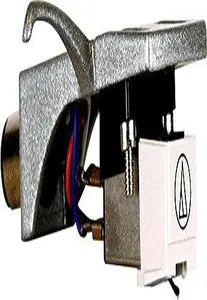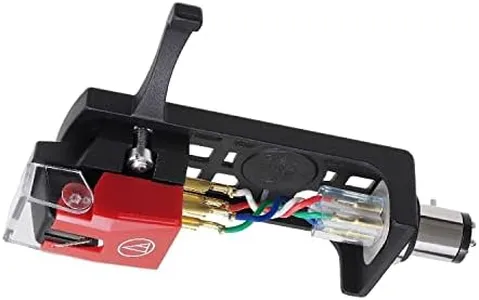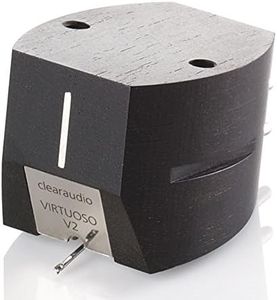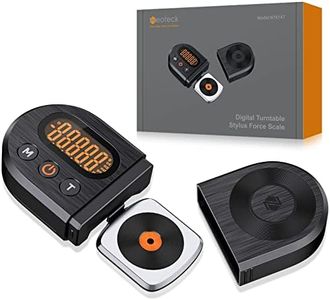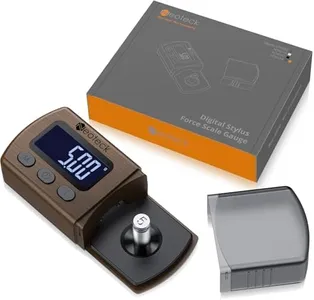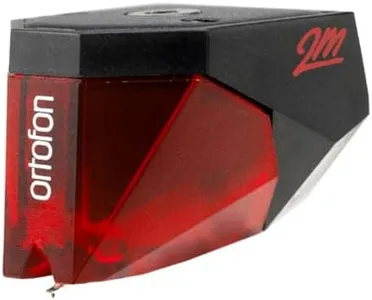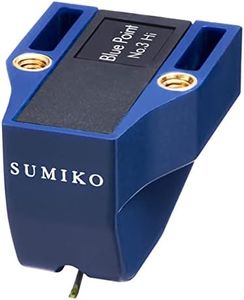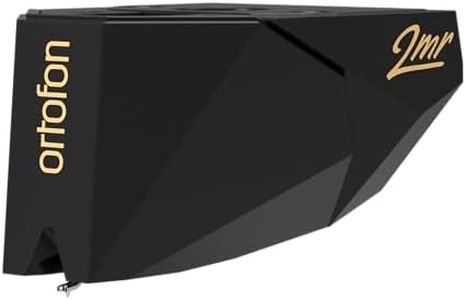10 Best Phono Cartridges 2025 in the United States
Our technology thoroughly searches through the online shopping world, reviewing hundreds of sites. We then process and analyze this information, updating in real-time to bring you the latest top-rated products. This way, you always get the best and most current options available.

Our Top Picks
Winner
Ortofon 2M Blue Moving Magnet Phono Cartridge (Stealth Edition)
Most important from
1028 reviews
The Ortofon 2M Blue Stealth is a popular moving magnet (MM) phono cartridge known for delivering a noticeable improvement in sound quality compared to basic models like the 2M Red. It uses a nude elliptical stylus, which is a good balance between detailed sound and cartridge life, allowing it to pick up more musical details and provide clearer, more open sound. The cartridge offers a relatively high output voltage of around 5.5 mV, making it compatible with most standard phono preamps without needing extra amplification. The tracking force and compliance (how easily the stylus moves with grooves) are well matched to work smoothly on most turntables, supporting stable playback and reducing wear on your records.
Its design also includes split pole pins with copper wire for better signal quality. The 2M Blue Stealth fits universally, so it should mount easily on a wide range of turntables, and the stylus is replaceable, which extends the cartridge’s usable life. On the downside, while it delivers clear improvements in dynamics and resolution, it remains a mid-range cartridge and might not satisfy audiophiles looking for the absolute top-end sound quality found in moving coil (MC) cartridges. Also, users should ensure their turntable tonearm is compatible with the tracking force recommended by Ortofon to get the best performance.
This cartridge represents an excellent choice for those wanting a solid upgrade from entry-level MM cartridges, offering detailed and lively sound with easy installation and maintenance.
Most important from
1028 reviews
Audio-Technica VM540ML/H Turntable Headshell/Cartridge Combo Kit Red
Most important from
1167 reviews
The Audio-Technica VM540ML/H Headshell/Cartridge Combo Kit offers a notable performance for vinyl enthusiasts. As a Moving Magnet (MM) cartridge, it provides easier compatibility with a wide range of phono preamps and headshells. The MicroLine stylus stands out in its ability to trace record grooves with high precision, yielding detailed and clear playback. This stylus shape is particularly adept at minimizing wear on records and enhancing longevity, which is a significant advantage for collectors and frequent listeners alike.
The aluminum cantilever contributes to the unit's durability and stability during playback. Additionally, the par toroidal coils are designed to improve generating efficiency, which can result in a clearer audio signal, while the center shield plate helps reduce crosstalk between channels, ensuring a more distinct stereo separation. The lightweight aluminum headshell, included in the combo kit, is an added convenience for users, offering straightforward setup and improved tracking accuracy.
As with any high-performance phono cartridge, the VM540ML/H requires careful setup and optimal tracking force adjustment, typically around 2.0 grams, to prevent unnecessary wear and to achieve the best sound quality. The compliance is suitable for most modern tonearms, but users with vintage or highly sensitive setups might need to verify compatibility. At an output voltage of around 4.0 mV, it provides a robust signal suitable for most phono inputs, though those seeking ultra-high output might find it slightly lacking. This cartridge combo is a solid choice for both casual and discerning listeners, offering a blend of high-fidelity playback, durability, and ease of use.
Most important from
1167 reviews
Ortofon Concorde Music Black Phono Cartridge Tool-Free Installation on S-shaped Tone Arms
The Ortofon Concorde Music Black Phono Cartridge is a solid option for both budding DJs and home audio enthusiasts looking for quality sound without a complex installation process. One of its standout features is the easy, tool-free installation, making it a breeze to set up on S-shaped tonearms. This design is particularly friendly for users who may not have much technical experience or who prefer quick adjustments. The silver-plated oxygen-free copper quad-coil system enhances sound quality, ensuring clear and detailed audio reproduction, which is essential for music playback and DJ performances alike.
However, there are a few points to consider. The Concorde Music Black is designed primarily for specific tonearms, limiting its compatibility with other setups. As it is a Moving Magnet (MM) cartridge, it may not offer the same level of detail and nuance as higher-end Moving Coil (MC) cartridges, which could be a drawback for audiophiles seeking the utmost sound fidelity. The upgrade path through the series can be a plus, allowing users to improve their setup over time by simply replacing the stylus, but some may find the initial investment still a bit on the pricey side compared to entry-level alternatives.
The Ortofon Concorde Music Black is well-suited for DJs and casual music listeners looking for an easy-to-install, quality cartridge that performs reliably. It excels in user-friendliness and sound quality, but those seeking the best possible audio experience might want to explore MC options or ensure that it is compatible with their equipment before purchasing.
Buying Guide for the Best Phono Cartridges
Choosing the right phono cartridge is essential for getting the best sound quality from your turntable. A phono cartridge is the component that holds the stylus (needle) and converts the vibrations from the grooves of a vinyl record into an electrical signal that can be amplified and played through speakers. The right cartridge can make a significant difference in the clarity, warmth, and overall enjoyment of your vinyl records. Here are some key specifications to consider when selecting a phono cartridge.FAQ
Most Popular Categories Right Now
